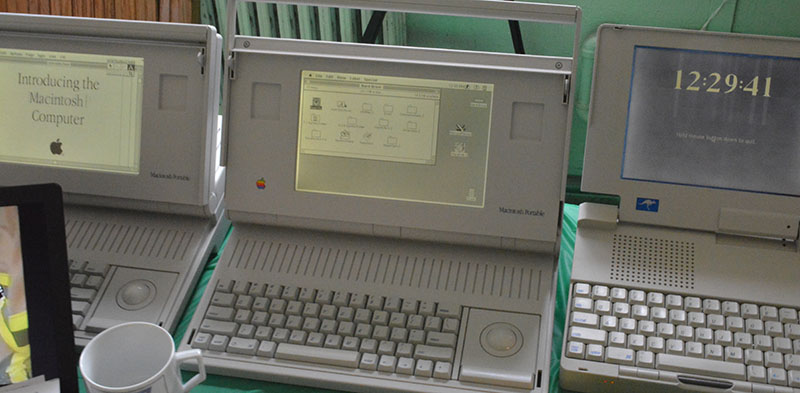The Amiga 1000, the original Amiga, was introduced in 1985, making this the 30th anniversary of the Commodore Amiga. Of course this needed to be represented at the Vintage Computer Festival, and [Bill Winters] and [Anthony Becker] were more than up to the task:
The guys brought with them a representation of nearly every Amiga, and also have a few neat gadgets to plug into these cool little boxes. The Amiga 1200 has been heavily upgraded with a compact flash drive. With the proper adapters and cards, this neat machine can be upgraded with Ethernet, WiFi, or just about every conceivable networking solution.
Attached to the A500 is a Gotek floppy drive emulator, a relatively standard if weird device that turns a PC floppy drive connector into a USB mass storage solution. This floppy emulator did not originally support Amiga disk formats, but with a firmware modification, everything just works. That’s a great story in itself, and something we should probably cover another time.
If you’re wondering what it was like for [Bill] and [Anthony] to dig through their garage for their exhibit, here you go.
Portable Macintoshen
The first Macintosh was released in 1984. Macintosh users wanted a slightly more portable machine, but the first ‘luggable’ Mac wouldn’t be released until late 1989. The market was there to fill the gap, with some bizarre machines exhibited by [Matt Bergeron]:
The Outbound laptop and notebook were unlicensed clones of the Macintosh. Instead of pirating the Apple ROMs, the Outbound computers required buyers to pull the ROM chips from their Macs and install them in the slightly more portable version. This was, of course, inconvenient, and we can imagine there were more than a few ROM chips cloned.
The Dynamac was a different beast, using the entire PCB from a mac SE or SE/30. To this, the creators of the Dynamac added a custom video card and electroluminescent display that was also capable of driving an external monitor. Very cool stuff.
















Man, I miss my Amiga. I have two non-fully functional ones now. A 2000 and a 2500/030 with video toaster. Damn battery leakage.
I’m going to see my A1000 when we move. Yay, for being old.
GURU MEDITATION ERROR
+1 for the nostalgia. +1 for actually making me laugh out loud.
I still have the chips from my A2000 on a mega sized solder-less breadboard. I so want to make an Amiga portable with 2.1 ROM and the 16MB of RAM I had on 2 Supra Cards. That computer, along with the VIC-20 and C-64’s I had made me the person I am today. I wish I could have attended VCF:X. if Only I could SYS 64802 or SYS 64738 myself back a bit in life. :)
30+ years later and I still remember what those SYS commands do!
I did not follow a tech career path, but I still remember those commands as well. Also, I have a relatively comprehensive understanding of what all computers do thanks to my c-64 days.
I still have an Amiga 1200 with lots of mods and working great.
Shame commodore still not about today. They was way ahead in every way.
I had one of those MacIntosh Portables. It was a gift from a well-meaning friend, but it was also an amazing turd by just about every possible way you could view it. Mine did not have a backlight screen, requiring a lamp to be positioned just right; it took forever to start up; processor was way slow and underpowered, and it weighed a fucking ton. The best thing about it was I found someone who wanted it because it didn’t have a CRT (remember when some people were scared of CRT X-rays?), and I was able to unload it and get a nice Mac IIci, which I still have to this day (in storage…).
Ah the Amiga, just goes to show you that sometimes the fittest don’t always survive.
FRANKO INVENTED THE AMIGA
The Mac “Portable” used a very finicky lead-acid battery. It was in some ways ahead of its time – in how like a Li-Ion you didn’t want to run it totally dead or it would be *dead*. When running on AC power it didn’t run directly off the AC. The charging circuit kept the battery topped up while the computer always ran off the battery. An electric-electric series hybrid.
If you killed the battery you could not use the Portable. Many people have modded their Portables to run directly off AC or to install far less fragile (and lighter) batteries.
Even more fun, while the Portable’s hard drive is SCSI it uses a proprietary connector unique to it. Thus there were aftermarket adapters to replace the special cable so normal hard drives could be installed.
I still have 2 Outbound Notebooks, one still with the wire stand, strap, slipcase, etc. These laptops ran on camcorder batteries and required the Toolbox ROM chips from a donor Mac.
The same company also manufactured an external monochrome portrait CRT for the laptop that took the video signal from the SCSI (!) port.